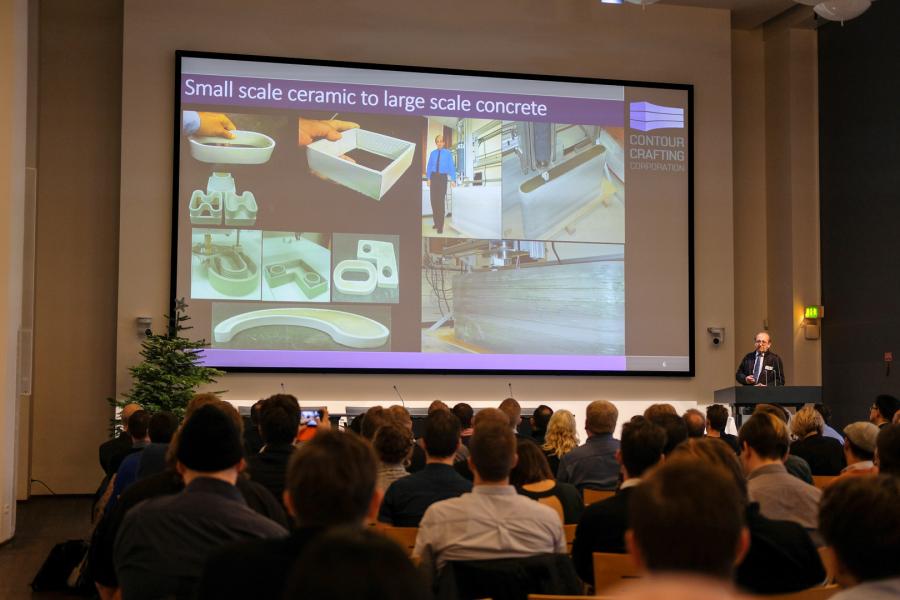
Wed December 27, 2017
Truck and Trailer Guide
It has been known for years that construction giant Skanska has been involved with Loughborrough University and the 3D construction printing research being undertaken there, but this year several new conventional construction giants have moved into 3D construction printing. European construction giants have especially become active participants in 3D construction printing likely due to the high labor costs in Europe, which 3D construction printing has the potential to reduce.
When French construction giant Vinci Construction earlier this year invested in Xtreee, the French 3D construction printing startup company, the chairman of Vinci, Jerome Stubler said, “3D printing offers revolutionary potential for the construction sector and Vinci Construction plans to be in the vanguard of the move to introduce it.”
During the 3D construction printing conference in Copenhagen last month, organized by Danish 3D Printhuset, who has recently completed 3D printing the first building in Europe, Vinci was there to present its views together with several other representatives from the conventional construction sector. Among the speakers and attendees were representatives from construction materials giants including Holcim, Lafarge, CRH Group, Italcementi/Aalborg Portland, Saint Gobain and Bekaert, General contractors, such as Zublin, Royal BAM, Acciona and NCC, were also present. Menno de Jonge, director of Digital Construction at Royal BAM Group, the Dutch general contractor who recently completed a 3D printed bicycle bridge in Holland, explained the reason why Royal BAM had begun to invest in the application of 3D construction printing.
“Using 3D printing techniques we will move major parts of our construction works to factories in order to raise productivity,” he said.
The conference in Copenhagen demonstrated that the conventional construction industry seems to have concluded that 3D construction printing will grow significantly in the coming years and conquer a significant part of the construction market leading more and more companies from the conventional construction industry to become involved. Armin Bruehwiler, from materials giant Sika Group called it a “movement, that we are proud to be part of” and gave a presentation about Sika's project to develop materials dedicated to 3D construction printing, as Sika predicts a large market for such materials.
Similarly, Werner Bittner from Austrian Doka Construction explained why Doka recently decided to invest in Contour Crafting Corporation, the company of Berok Khoshnevis, the originator of the concept of 3D construction printing, saying, “We firmly believe that 3D construction printing is a potentially disruptive technology, and that Contour Crafting Corporation is the leading firm that will become a globally successful company.”
With the entry of some of the giants and their vast resources from the conventional construction industry into the 3D construction printing industry, the emerging result is heading for a promising future. In 2018, it is expected that more companies from the conventional industry will make the move to also become part of the movement.
It has been known for years that construction giant Skanska has been involved with Loughborrough University and the 3D construction printing research being undertaken there, but this year several new conventional construction giants have moved into 3D construction printing. European construction giants have especially become active participants in 3D construction printing likely due to the high labor costs in Europe, which 3D construction printing has the potential to reduce.
When French construction giant Vinci Construction earlier this year invested in Xtreee, the French 3D construction printing startup company, the chairman of Vinci, Jerome Stubler said, “3D printing offers revolutionary potential for the construction sector and Vinci Construction plans to be in the vanguard of the move to introduce it.”
During the 3D construction printing conference in Copenhagen last month, organized by Danish 3D Printhuset, who has recently completed 3D printing the first building in Europe, Vinci was there to present its views together with several other representatives from the conventional construction sector. Among the speakers and attendees were representatives from construction materials giants including Holcim, Lafarge, CRH Group, Italcementi/Aalborg Portland, Saint Gobain and Bekaert, General contractors, such as Zublin, Royal BAM, Acciona and NCC, were also present. Menno de Jonge, director of Digital Construction at Royal BAM Group, the Dutch general contractor who recently completed a 3D printed bicycle bridge in Holland, explained the reason why Royal BAM had begun to invest in the application of 3D construction printing.
“Using 3D printing techniques we will move major parts of our construction works to factories in order to raise productivity,” he said.
The conference in Copenhagen demonstrated that the conventional construction industry seems to have concluded that 3D construction printing will grow significantly in the coming years and conquer a significant part of the construction market leading more and more companies from the conventional construction industry to become involved. Armin Bruehwiler, from materials giant Sika Group called it a “movement, that we are proud to be part of” and gave a presentation about Sika's project to develop materials dedicated to 3D construction printing, as Sika predicts a large market for such materials.
Similarly, Werner Bittner from Austrian Doka Construction explained why Doka recently decided to invest in Contour Crafting Corporation, the company of Berok Khoshnevis, the originator of the concept of 3D construction printing, saying, “We firmly believe that 3D construction printing is a potentially disruptive technology, and that Contour Crafting Corporation is the leading firm that will become a globally successful company.”
With the entry of some of the giants and their vast resources from the conventional construction industry into the 3D construction printing industry, the emerging result is heading for a promising future. In 2018, it is expected that more companies from the conventional industry will make the move to also become part of the movement.
 Truck and Trailer Equipment
Truck and Trailer Equipment Articles
Articles Email Updates
Email Updates Sell Your Machines
Sell Your Machines

 Truck and Trailer Equipment
Truck and Trailer Equipment Truck and Trailer Dealers
Truck and Trailer Dealers Truck and Trailer Articles
Truck and Trailer Articles Email Updates
Email Updates Sell Your Machines
Sell Your Machines